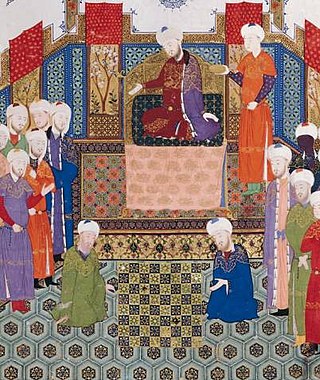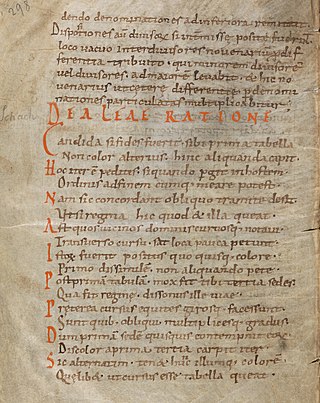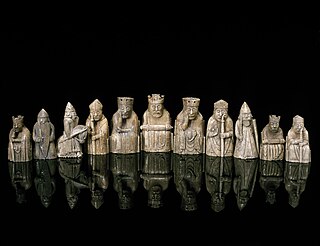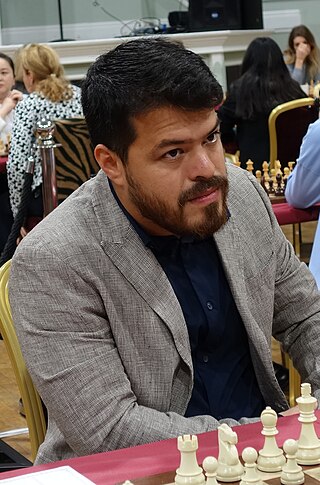Related Research Articles

Chess is a board game for two players. It is sometimes called international chess or Western chess to distinguish it from related games such as xiangqi and shogi.

Xiangqi, commonly known as Chinese chess or elephant chess, is a strategy board game for two players. It is the most popular board game in China. Xiangqi is in the same family of games as shogi, janggi, Western chess, chaturanga, and Indian chess. Besides China and areas with significant ethnic Chinese communities, this game is also a popular pastime in Vietnam, where it is known as cờ tướng, literally 'General's chess'.

Shatranj is an old form of chess, as played in the Sasanian Empire. Its origins lie in the Indian game of chaturanga. Modern chess gradually developed from this game, as it was introduced to Europe by contacts in Muslim Al-Andalus and in Sicily in the 10th century. In modern Persian, the term is also used as the translation of chess.
The game of chess, or rather its immediate precursor, known as shatranj, was introduced to Europe from the Islamic sphere, most likely via Iberia, in the 9th or 10th century.
Alexander Neckam was an English poet, theologian, and writer. He was an abbot of Cirencester Abbey from 1213 until his death.

Chaturanga is an ancient Indian strategy board game. It is first known from India around the seventh century AD.

Versus de scachis, also known as the Einsiedeln Poem in some literature, is the title given to a 10th-century Medieval Latin poem about chess. It is the first known European text to provide a technical description of chess for didactic purposes and it is considered a fundamental document to understand the development of chess in Europe.
Luis Ramírez de Lucena was a Spanish chess player who published the first extant chess book. He is believed to be the son of humanist writer and diplomat Juan de Lucena.
This is a timeline of chess.

The history of chess can be traced back nearly 1,500 years to its earliest known predecessor, called chaturanga, in India; its prehistory is the subject of speculation. From India it spread to Persia, where it was modified in terms of shapes and rules and developed into Shatranj. Following the Arab invasion and conquest of Persia, chess was taken up by the Muslim world and subsequently spread to Europe via Spain and Italy. The game evolved roughly into its current form by about 1500 CE.

A chess set consists of a chessboard and white and black chess pieces for playing chess. There are sixteen pieces of each color: one king, one queen, two rooks, two bishops, two knights, and eight pawns. Extra pieces may be provided for use in promotion, most commonly one extra queen per color. Chess boxes, chess clocks, and chess tables are common pieces of chess equipment used alongside chess sets. Chess sets are made in a wide variety of styles, sometimes for ornamental rather than practical purposes. For tournament play, the Staunton chess set is preferred and, in some cases, required.

Scachs d'amor, whose complete title is Hobra intitulada scachs d'amor feta per don Francí de Castellví e Narcis Vinyoles e mossén Fenollar, is the name of a poem written by Francesc de Castellví, Bernat Fenollar, and Narcís Vinyoles, published in Valencia, Crown of Aragon, towards the end of the 15th century.

China is a major chess power, with the women's team winning silver medals at the Olympiad in 2010, 2012, and 2014; the men's team winning gold at the 2014 Olympiad, and the average rating for the country's top ten players third in the FIDE rankings as of April 2023.

Chess became a source of inspiration in the arts in literature soon after the spread of the game to the Arab World and Europe in the Middle Ages. The earliest works of art centered on the game are miniatures in medieval manuscripts, as well as poems, which were often created with the purpose of describing the rules. After chess gained popularity in the 15th and 16th centuries, many works of art related to the game were created. One of the best-known, Marco Girolamo Vida's poem Scacchia ludus, written in 1527, made such an impression on the readers that it singlehandedly inspired other authors to create poems about chess.

Arturo Pomar Salamanca was a Spanish chess player. He was the first Spanish player to be awarded the title of grandmaster (GM), and was a seven-time national champion.

The history of games dates to the ancient human past. Games are an integral part of all cultures and are one of the oldest forms of human social interaction. Games are formalized expressions of play which allow people to go beyond immediate imagination and direct physical activity. Common features of games include uncertainty of outcome, agreed upon rules, competition, separate place and time, elements of fiction, elements of chance, prescribed goals and personal enjoyment.

Eduardo Patricio Iturrizaga Bonelli is a Venezuelan-born Spanish chess player. He was awarded the title Grandmaster by FIDE in 2008, making him the first Venezuelan to achieve this. He competed in the FIDE World Cup in 2007, 2009, 2013, and 2015. He is a four-time Venezuelan champion and has represented his country at eight Chess Olympiads.

Playing cards were most likely invented in China during the Southern Song dynasty (1127–1279). They were certainly in existence by the Mongol Yuan dynasty (1271-1368). Chinese use the word pái (牌), meaning "plaque", to refer to both playing cards and tiles. Many early sources are ambiguous, and do not specifically refer to paper pái (cards) or bone pái (tiles); but there is no difference in play between these, as either serves to hide one face from the other players with identical backs.
References
- ↑ "Meng Changjun Played Xiangqi and Danced with Lady Zheng". www.yutopian.com. Retrieved 2024-11-07.
- ↑ Murray, H.J.R (1913). A History Of Chess. Clarendon Press. p. 122.
- ↑ Melchor, Alejandro (2020-05-27). "Los testamentos del Conde Ermengol de Urgell (1008) y su cuñada, Ermessenda de Carcassone (1058)". Historia del ajedrez español (in Spanish). Retrieved 2023-12-08.
- ↑ Gude, Antonio (2017-01-02). "Historia del ajedrez (29): Testamentos e inventarios". Curiosidades sobre ajedrez, literatura y cine (in Spanish). Retrieved 2023-12-08.
- ↑ Helena M. Gamer: "The Earliest Evidence of Chess in Western Literature: The Einsiedeln Verses", Speculum, Vol. 29, No. 4 (1954), pp. 734–750
Bibliography
- Helena M. Gamer, "The Earliest Evidence of Chess in Western Literature: The Einsiedeln Verses", Speculum, Vol. 29, No. 4. (October 1954), pp. 734–750.
- Murray, H. J. R. (1913). A History of Chess (Reissued ed.). Oxford University Press. ISBN 0-19-827403-3.